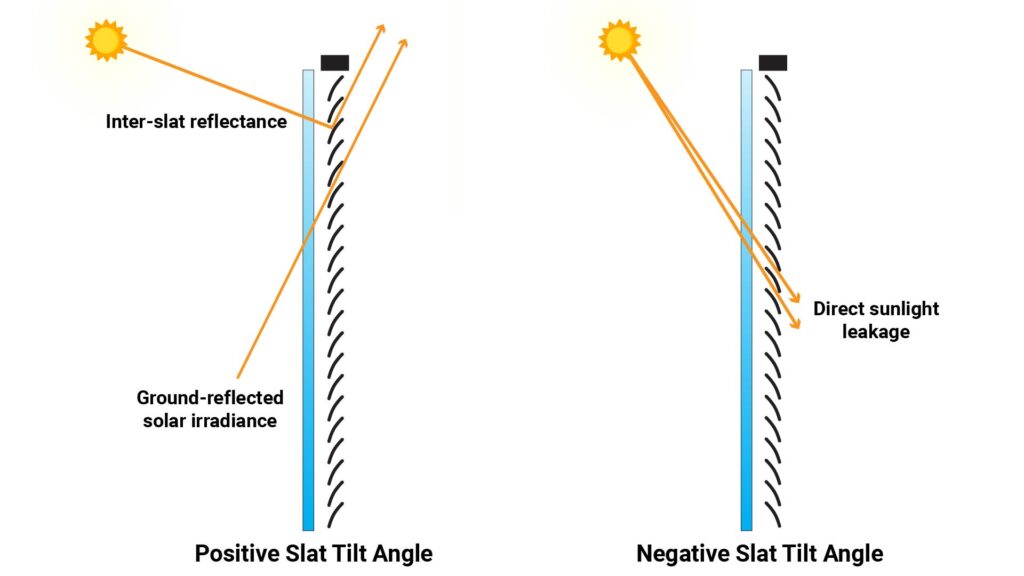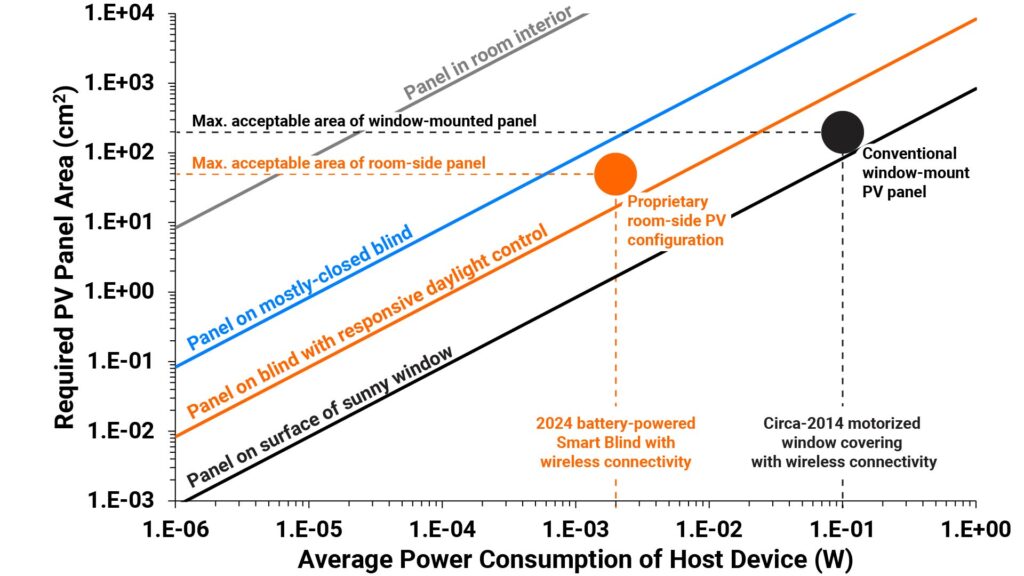Modular headrail-mounted power system for smart blinds

What it does
How it works
Advantages
Product applications
Detailed Description
Customers of Automated Shading Products Demand Power Options
The option to use a power source other than mains-derived power (e.g. primary batteries, manually-recharged secondary batteries, or solar-charged secondary batteries) is essential for many potential purchasers of automated shading products. Fortunately, the hottest products in today’s automated shading market—headrail-mounted automation devices for wand-operated horizontal blinds—have a power consumption that’s low enough to enable the use of alternative power sources.
Unfortunately, conventional approaches to providing power options for such devices suffer from significant limitations.
The Problem with Conventional Battery Holders and Battery Packs
Of course, the most significant limitation of primary and secondary battery power is the need for periodic replacement or recharging. This limitation is exacerbated if the batteries (or charging port) are difficult to access.
Another potential limitation of batteries is the size and weight necessary to provide a reasonably long run time. This is generally not an problem for products with a long, tubular form-factor (which have plenty of space to accommodate a linear battery stack, e.g. of several AA-sized batteries), but can be an issue for other product form-factors.
The Problem with Conventional Solar Power Panels
A conventional solar power source for an automated shading product consists of a window-mounted solar panel and a cable connecting the panel to the product. Unfortunately, such cables are unsightly, and the need to install the panel and cable is a significant drawback.
Our Solution: a Modular Power System
We’ve developed a modular power system for headrail-mounted window coverings which mitigates the above-described disadvantages. Two of its key features are (1) bilaterally symmetrical power connectors, and (2) an outward-facing photovoltaic power module mounted on the room-side of the window covering.
Bilaterally Symmetrical Power Connectors
Our market research shows that battery power for a smart blind product is best provided by a separate optional battery module, rather than by including a battery holder inside the main product housing. This is advantageous because it reduces the size and cost of the main product in applications where the customer will use hardwired or solar-charged power instead of battery power.
To facilitate the use of a separate battery module, our modular power approach equips the main product with bilaterally symmetrical power connectors, as shown below on our IntelliBlind™ smart miniblind actuator:

This enables a power source—which can be a battery module, hardwired cable, or other device—to be attached on either side of the main product. This configuration can power products which can be installed on only one specific side of the headrail (as is the case with virtually all headrail-motorization devices). The ability to accommodate both right-side and left-side installations is shown below with IntelliBlind™ and a battery module:

Our reference design uses magnetic spring-loaded (“pogo-pin”) power connectors, which are self-aligning and require no insertion force, for exceptionally easy coupling. The battery module is also equipped with a cup magnet to hold it to the host blind’s headrail:

This enables the battery module to be instantly and effortlessly attached and removed for battery replacement.
Advantages
In addition to avoiding the need for a battery holder inside the main product housing (reducing size and cost in applications where battery power won’t be used), the use of bilaterally symmetrical power connectors provides six key advantages:
- When hardwired power is being used, it allows the power cable to be connected on either side of the main product to accommodate different blind designs
- It eliminates the need for a cable when battery power is used.
- The magnetic mount and self-aligning magnetic connectors enable the battery module to be instantly and effortlessly attached and removed for battery replacement.
- The weight of the battery module isn’t borne by main product, eliminating the need for locking connectors that would be required if the battery module were mounted underneath the main product.
- Because the battery module is mounted to the side of the main module, instead of underneath it, there is no risk of interference between the battery module and the blind’s slats
- The battery module’s horizontal form factor harmonizes with the shape of the headrail.
Room-Side Photovoltaic Power Module
Photovoltaic power is an appealing alternative to mains or battery power for many applications, so many smart blind products include optional window-mounted solar panels. However, mounting a solar panel to the window adds another step to the installation process, and so does the unsightly cable between the solar panel and the product.
To overcome these disadvantages, our proprietary solution uses a headrail-mounted, outward-facing photovoltaic panel located on the room side of the blind. The approach is illustrated with our IntelliBlind™ reference design:

This configuration might seem silly because the blind will typically be closed in bright sunlight, drastically reducing the panel’s average power output. In fact, numerous studies have confirmed that most manually-operated blinds on sunny windows do remain mostly closed.
However, even a blind that’s mostly closed can still admit a significant amount of daylight in a direction parallel to the slats:

This daylight is traveling at too steep an angle to penetrate deep into the room, but can sometimes be seen as a bright spot on either the ceiling (when the slat tilt angle is positive) or the floor (when the slat tilt angle is negative) near the blind. We mount the PV panel close enough to the slats to capture this irradiance “leakage”. There is a sine loss because the leakage impinges the panel at an oblique angle, but the panel still generates power.
To be more specific, an outward-facing PV panel mounted on the room-side of a mostly-closed blind on a sunny window will generate about 1% of the power of the same-sized panel mounted directly on the window. That might not seem like much, but it’s enough to power many devices—and it’s two orders of magnitude more power than could be obtained from just the ambient illumination in the room.
Further, if the blind is motorized, our optional power-management algorithm can adjust the blind’s fully-closed setting (i.e. its maximum slat-tilt angle) to maximize off-axis daylight “leakage” while still fully blocking direct sunlight, thereby tripling the average power output relative to a tightly closed blind.
Even further increases in average power can be obtained if the slats are automatically tilted only as much as necessary to block glare. We call this responsive daylight control, and it’s one of the signature capabilities of our IntelliBlind™ smart blind actuator.
The impact of responsive daylight control on the power output of our proprietary room-side PV panel configuration is evident in the following figure. It plots the power ratio versus slat-tilt angle, where the power ratio is the power output of an identically-sized PV panel mounted directly on the window (in the conventional manner) divided by the output of the room-side panel. Thus, the lower the power ratio, the better the relative performance of the room-side panel. The data were collected at 5-minute intervals over several winter days on a south-facing window in the metro-DC area:

For the 5-minute-sampled data of Figure 6, the relative power ratio never exceeded 10, even when the blind was almost fully closed. Thus, the room-side panel was generating at least 10% of the power of the window-side panel—about an order of magnitude more than if the blind had always remained mostly closed.
Of course, what’s really important for a photovoltaic power source is the amount of energy that can be collected over time, not the instantaneous power output. The following figure plots the cumulative energy collected by the two panels of Figure 6 over several days:

On average, the room-side panel collects about 10% of the energy of the identically-sized window-mounted panel. That’s ten times more energy than if the blind were always fully closed—and with no risk of daylight glare. More importantly, it’s enough to power a wide range of devices with a reasonably-sized PV panel.
To put that in perspective, the following figure shows the required PV panel area versus required average power output for several panel configurations (assuming a south-facing window in the metro-DC area, and accounting for year-round and daily variations in solar irradiance):

Figure 8 includes plots for four PV panel configurations:
- Direct window mounting (in the conventional manner)
- Our proprietary room-side configuration on a blind that is performing responsive daylight control (in this case, the blind was equipped with our IntelliBlind™ Smart Blind actuator)
- Our proprietary room-side configuration on a blind with a fixed, mostly-closed slat-tilt angle of 75 degrees
- Mounting in the room interior to capture ambient illumination
As Figure 8 shows, a relatively large (200 cm2) PV panel mounted directly on the window is necessary to power a device with an average power consumption of ~100 mW, like a circa-2014 motorized window covering with wireless connectivity.
However, thanks to the recent emergence of power-efficient microcontrollers and low-power wireless protocols, Smart Blinds are now available with average power consumptions of just a couple of mW. That’s low enough to be powered by AA batteries—and also by a reasonably small PV panel in our proprietary room-side configuration when the panel is mounted on a blind that’s performing responsive daylight control.
Even on a blind with a fixed, mostly-closed setting, our room-side PV panel configuration can power a device with an average consumption of 0.5 mW, which is more than enough for a wireless smart sensor like our IntelliLux™ headrail sensor—and two orders of magnitude more than a PV panel that faces inward toward the room to capture ambient illumination.
Effects of Window Azimuth Orientation
The data of Figures 6–8 are conservative in the sense that they were collected in winter and on a window with significant shading from nearby buildings. On the other hand, they are also optimistic in the sense that they were collected on a south-facing window in the metro-DC area, and south is the optimum compass orientation for solar energy collection in the northern hemisphere. This begs an obvious question: how would our room-side PV panel perform with a non-optimal compass orientation?
The short answer is that the performance would be about the same on any window that occasionally receives direct sunlight (i.e. one with an eastern, western, or southern orientation in the northern hemisphere).
Here’s why: unlike a conventional window-mounted PV panel, the average power output of our room-side panel depends not just on the average solar irradiance on the window, but also on the degree of “openness” of the host blind. And since the average degree of openness of a blind (whether manually or automatically operated) varies inversely with the average irradiance on the host window, the power output is relatively insensitive to the average irradiance on the window—at least on windows that occasionally receive direct sunlight.
Advantages
Our room-side PV panel configuration is not well-suited to products which are too power-hungry to be powered by small primary batteries. However, products that can be powered by AA-sized batteries (i.e., products with an average power consumption in the milliwatt class) are the hottest segment of today’s automated shading market—and our approach is the best way to solar-power such products on sunny windows:
- While the configuration does increase the required panel size for a given power output, the panel is still small enough to be visually unobtrusive and amenable to integration in a headrail-mounted motorization device like IntelliBlind™.
- Because the panel is still small in absolute terms, the additional cost over a still-smaller window-mounted panel is modest. Further, that incremental cost is more than offset by the elimination of the need for the separate housing, mounting provisions, and wiring/connectors needed for a window-mounted panel.
- Aside from the cost advantages, the elimination of the need for a separate window-mounted panel makes for a much sleeker, easier-to-install product.
Provides Four Power Options
Our modular power system provides a headrail-mounted blind automation device with four convenient power options, as shown below with our IntelliBlind™ Smart Miniblind Actuator:

1. Pure Battery Power
Pure battery power is an appealing option for windows which receive little sunlight and where hardwired power isn’t feasible. As previously described, our modular power system enables an optional battery module which can be magnetically attached on either side of the host device, accommodating various blind designs.
2. Pure Photovoltaic Power
Pure photovoltaic power (with Li-Ion or supercapacitor energy storage) is appealing for windows which receive significant sunlight, and when hardwired power and the need for periodic battery replacement must be avoided. Our room-side photovoltaic power source can be in the form of a module integrated into the host device (either removably, as is the case with IntelliBlind™, or permanently), or it can be separately attached to the headrail via one of the bilaterally symmetrical power connectors. This eliminates the need for a window-mounted panel and the associated wiring, reducing cost, facilitating installation, and making for a sleeker appearance.
3. Hardwired Power
Hardwired power is necessary on windows which receive little sunlight and when the need for periodic battery replacement must be avoided. Our bilaterally symmetrical power connectors enable hardwired power to be fed from either the right or the left side of the host device, facilitating left-side and right-side mounting, respectively, of the host device on the headrail.
4. Battery Plus Photovoltaic Power
In some product applications, neither battery power alone nor photovoltaic power alone will provide sufficient run time. Accordingly, many power-harvesting ICs are designed to be able to use a photovoltaic source to extend a primary battery’s operating life. Our IntelliBlind™ reference design uses such a power-harvesting circuit, and our modular power system makes this kind of solar “battery extender” operation especially convenient for the user.
Applications
Our bilaterally symmetrical power connectors are advantageous for any blind-motorization device that can be battery-powered, such as our IntelliBlind™ smart miniblind actuator shown above. Our room-side PV panel is applicable to any device mounted on the headrail of a venetian blind that has an average power consumption in the milliwatt class, such as IntelliBlind™ and the headrail-mounted variant of our IntelliLux™ smart sensors.
